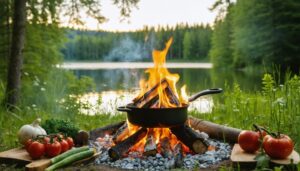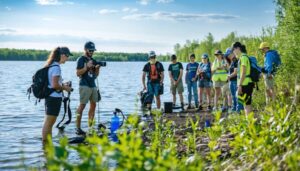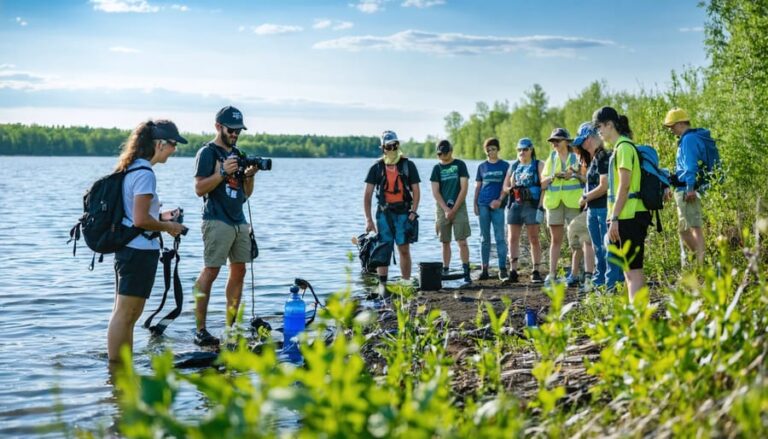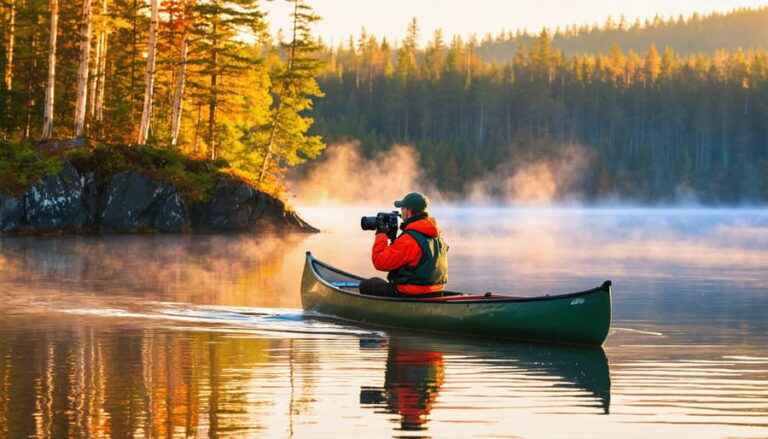Pack your tent, silence your phone, and step away from the daily chaos – a personal retreat in Ontario’s wilderness offers the reset button your soul craves. Whether it’s a weekend in Algonquin’s pine-scented forests or a peaceful day trip to the Bruce Peninsula’s rocky shores, creating space for solitude has become more than a luxury – it’s essential self-care in our hyper-connected world.
Imagine waking to birdsong instead of email notifications, spending uninterrupted hours hiking moss-covered trails, and watching sunset paint the lakes in gold – all while reconnecting with your inner compass. Personal retreats combine the healing power of nature with intentional solitude, creating perfect conditions for reflection, renewal, and personal growth.
Unlike structured group retreats, these solo adventures let you set your own pace and agenda. Camp by a pristine lake, meditate on sun-warmed rocks, or simply sit quietly with your journal as chickadees flit through nearby branches. Ontario’s diverse parks and conservation areas provide the perfect backdrop for your journey inward, whether you’re seeking creative inspiration, emotional healing, or simply a peaceful break from routine.
The beauty of personal retreats lies in their simplicity – just you, your essential gear, and the transformative power of wild spaces.
Why Ontario’s Parks Are Perfect for Personal Retreats
Natural Sanctuaries: From Forests to Lakes
From the misty shores of Georgian Bay to the serene wilderness of Algonquin, Ontario’s wild spaces offer countless natural sanctuaries perfect for personal reflection. Each landscape presents its own unique retreat experience: dense forests provide a protective canopy for meditation, while crystal-clear lakes offer peaceful shorelines for contemplation.
For forest lovers, the old-growth stands in Temagami create natural cathedral-like spaces where towering white pines filter sunlight through their branches. These quiet woods naturally invite mindfulness and connection with the earth. Meanwhile, the Kawarthas’ countless lakes provide waterfront havens where the gentle lapping of waves creates nature’s own meditation soundtrack.
Looking for something different? The dramatic cliffs of the Niagara Escarpment offer elevated perspectives for clarity and inspiration, while the wetlands of Long Point provide bird-watching sanctuaries where wildlife observation becomes a form of moving meditation. Pro tip: Consider visiting during shoulder seasons (spring and fall) when these natural spaces are less crowded and wildlife is most active.

Seasonal Beauty: When to Plan Your Retreat
Every season paints Ontario’s wilderness with a different brush, making the timing of your personal retreat crucial to the experience you seek. Seasonal changes in Ontario parks offer unique opportunities for reflection and renewal throughout the year.
Spring brings the gentle awakening of nature, with wildflowers dotting the trails and migrating birds returning home. It’s perfect for those seeking inspiration in new beginnings, though be prepared for muddy trails and occasional rain showers.
Summer offers the most accessible conditions for first-time retreat-goers, with warm days perfect for swimming and extended hiking. However, consider mid-week visits to avoid peak crowds and ensure the solitude you’re seeking.
Fall might be the most magical time for a personal retreat, with crisp air and stunning foliage creating a contemplative atmosphere. The bugs are gone, and the temperatures are ideal for outdoor activities.
Winter transforms parks into pristine wonderlands, offering supreme solitude for experienced outdoor enthusiasts. While requiring more preparation, winter retreats provide unmatched tranquility and clarity beneath snow-laden trees.
Pro tip: Book your retreat during shoulder seasons (early spring or late fall) for the perfect balance of favorable weather and peaceful surroundings.
Planning Your Solo Park Retreat

Essential Gear and Supplies
Packing for your personal retreat requires thoughtful consideration of both essential items and comfort luxuries. Start with the basics: a reliable tent or sleeping bag, weather-appropriate clothing (including layers), and a good-quality headlamp or flashlight with extra batteries. Don’t forget your first-aid kit, including any personal medications and basic supplies like bandages and antiseptic wipes.
For comfort and practicality, pack a camping chair or cushion for meditation and reflection time. A journal and pen are invaluable tools for documenting your thoughts and experiences. Consider bringing inspiring books or spiritual materials that align with your retreat goals.
Eco-friendly tip: Pack reusable water bottles and food containers to minimize waste. A proper food storage container is essential to keep wildlife away from your campsite.
For self-care, include items like natural bug spray, sunscreen, and basic toiletries. A small camping pillow and cozy blanket can make your experience much more comfortable. Consider bringing earplugs and an eye mask if you’re sensitive to nature’s sounds and early morning light.
Technology is a personal choice – while many prefer to disconnect completely, others might want a camera to capture moments or a power bank for emergencies. Whatever you choose, remember that simplicity is key. Each item should serve a purpose in supporting your retreat experience.
Remember to check the weather forecast before packing and adjust your gear accordingly. A lightweight tarp can be invaluable for unexpected rain showers.
Choosing Your Spot: Top Secluded Locations
Ontario’s vast wilderness offers countless hidden gems perfect for personal reflection and solitude. In Algonquin Park, the secluded Crow Lake trail leads to a peaceful lookout point where you’ll rarely encounter other hikers, especially during weekday mornings. The moss-covered rocks and ancient white pines create a natural sanctuary for meditation or journaling.
For those seeking waterfront tranquility, consider the lesser-known David Creek area in Killarney Provincial Park. Here, smooth Canadian Shield rocks form natural seats overlooking the crystal-clear waters, particularly magical during sunrise. Visit during shoulder season (May or September) for maximum solitude.
Silent Lake Provincial Park lives up to its name with several tucked-away spots along its hiking trails. The Eastern Loop offers several private clearings perfect for setting up a meditation space, while the Western shore features quiet coves accessible only by foot.
In Bruce Peninsula National Park, venture beyond the popular Grotto to find solitude along the Bruce Trail’s inland routes. The ancient cedar forests near Little Cove provide natural seclusion and shelter, with fallen logs serving as perfect meditation perches.
Insider tip: Most visitors stick to designated camping areas and main attractions. For true solitude, plan your retreat for early mornings or weekdays, and hike at least 1-2 kilometers beyond the main trails. Always remember to respect trail markers and park boundaries while seeking your perfect spot.
Safety Considerations for Solo Retreats
While solo retreats can be deeply rewarding, safety should always be your top priority. Before heading out, always share your detailed itinerary with a trusted friend or family member, including your planned location, arrival and departure times, and check-in schedule. Pack a fully charged phone and a portable battery pack, but remember that some remote areas might have limited cell service.
Consider investing in a personal locator beacon (PLB) or satellite messaging device for added security, especially if you’re planning to venture into more isolated areas. Always check the weather forecast and park alerts before departing, and pack appropriate gear for changing conditions.
When you arrive at your chosen spot, familiarize yourself with the nearest ranger station and emergency facilities. Keep a basic first aid kit handy and know how to use it. It’s also wise to carry bear spray in areas where wildlife encounters are possible, and store your food properly to avoid attracting animals to your campsite.
Stay on marked trails and maintain awareness of your surroundings. While it’s tempting to fully immerse yourself in meditation or reflection, regular check-ins with your environment help ensure your safety. Consider scheduling your activities during daylight hours and choosing well-traveled areas for your first few solo experiences.
Trust your instincts – if something doesn’t feel right, it’s okay to change your plans or cut your retreat short. Remember, a safe retreat is a successful retreat.
Creating Your Retreat Experience

Mindful Activities in Nature
Immersing yourself in Ontario’s stunning natural beauty during your personal retreat can transform a simple getaway into a profound experience. Start your day with sunrise meditation by the lakeshore, letting the gentle lapping of waves and morning birdsong guide your practice. Forest bathing, or shinrin-yoku, is particularly magical in Ontario’s old-growth forests – take slow, mindful walks while focusing on each of your senses.
Try journaling beneath a centuries-old maple tree or beside a babbling brook. The peaceful surroundings often inspire deeper reflection and creativity. Photography can become a mindfulness practice too – challenge yourself to capture small details like dewdrops on spider webs or the intricate patterns in tree bark.
For a grounding experience, practice barefoot walking on safe trails or sandy beaches. This ancient practice, known as earthing, helps you connect directly with nature. Create your own outdoor art using fallen leaves, pine cones, and stones, then leave them for others to discover.
Consider trying moving meditation through gentle yoga or tai chi in a quiet clearing. The fresh air and natural surroundings enhance these practices beautifully. End your days with stargazing – Ontario’s dark sky preserves offer spectacular views of the cosmos, perfect for contemplative evening reflection.
Remember to respect the environment during these activities. Leave no trace, stay on marked trails, and maintain quiet to preserve the peaceful atmosphere for wildlife and fellow retreat-goers. These mindful practices will help you forge a deeper connection with nature while nurturing your inner peace.
Eco-Friendly Retreat Practices
When planning your personal retreat, embracing eco-friendly practices not only helps preserve Ontario’s beautiful wilderness but also deepens your experience of connecting with nature. Start by choosing reusable containers and utensils for your meals, and opt for a refillable water bottle instead of disposable plastic ones. Pack biodegradable soap and shampoo to protect local waterways, and always carry a reusable cloth bag for collecting any trash you find along the trails.
Consider using solar-powered chargers for essential devices, though we recommend minimizing technology use during your retreat. Choose environmentally conscious accommodation options, such as eco-lodges or designated camping areas that practice sustainable management. If you’re camping, stick to established sites to prevent damage to sensitive vegetation.
When preparing meals, opt for locally sourced, package-free ingredients when possible. This not only reduces waste but also supports local communities. Bring along a small compost bag for food scraps, which you can dispose of properly at designated facilities.
Leave-no-trace principles should guide your retreat experience. Stay on marked trails, avoid picking plants or flowers, and maintain a respectful distance from wildlife. Consider participating in trail maintenance or cleanup activities as part of your retreat – giving back to nature can be deeply fulfilling.
Remember to choose sustainable transportation options when possible. Consider carpooling to your destination or using public transit services that connect to Ontario’s parks. Some retreat locations are even accessible by bike, adding an extra layer of eco-friendly adventure to your journey.
Practical Tips from Experience
Having guided countless visitors through their first solo retreats, I’ve gathered some invaluable tips from both personal experience and fellow retreat enthusiasts. First, start small – a weekend retreat is perfect for beginners. Many first-timers try to plan two-week adventures and end up overwhelmed. I’ve found that 2-3 days allows you to settle into the experience while maintaining your comfort level.
Pack light but smart. A common mistake I see is bringing too many distractions. Instead of loading up your tablet with movies, bring one meaningful book and a journal. The point is to connect with yourself and nature, not recreate your home entertainment system. I always recommend bringing earplugs though – they’re invaluable for those not used to nighttime forest sounds.
Create a flexible schedule rather than a rigid itinerary. While structure helps, some of the most profound moments come from spontaneous experiences. I remember one retreat where an unexpected rainstorm led me to spend hours watching droplets on leaves – it became one of my most meditative experiences.
Stay somewhere with basic amenities for your first few retreats. While primitive camping has its place, having access to a proper bathroom and basic kitchen can help you focus on the internal work rather than survival skills. Many Ontario parks offer excellent cabin options that balance comfort with wilderness immersion.
Consider the season carefully. Fall is often ideal for beginners – fewer bugs, comfortable temperatures, and stunning colors. If you’re planning a winter retreat, ensure you have proper experience and equipment. Spring can be muddy but offers incredible wildlife viewing opportunities.
Don’t forget to inform someone about your plans and location. I always share my itinerary with a trusted friend and arrange check-in times. This provides peace of mind and allows you to fully immerse yourself in the experience without worrying about safety.
Lastly, bring a camera but use it mindfully. While documenting your experience can be valuable, avoid the urge to constantly photograph everything. Some moments are best experienced fully present, without a lens between you and nature.
Ontario’s parks offer the perfect canvas for personal transformation through mindful retreats. Whether you’re seeking clarity in the misty morning air of Algonquin, finding peace along Lake Superior’s rugged shores, or reconnecting with yourself amid the ancient cedars of Killarney, these natural sanctuaries provide the ideal setting for inner growth. A personal retreat isn’t just an escape – it’s an investment in your wellbeing, offering a chance to reset, reflect, and return to daily life with renewed purpose. By immersing yourself in Ontario’s wilderness, you’ll discover that the simple act of spending time alone in nature can spark profound changes in perspective. As you plan your own retreat, remember that every trail walked, every sunset witnessed, and every moment of solitude becomes part of your unique journey toward self-discovery in our province’s magnificent parklands.













+ There are no comments
Add yours